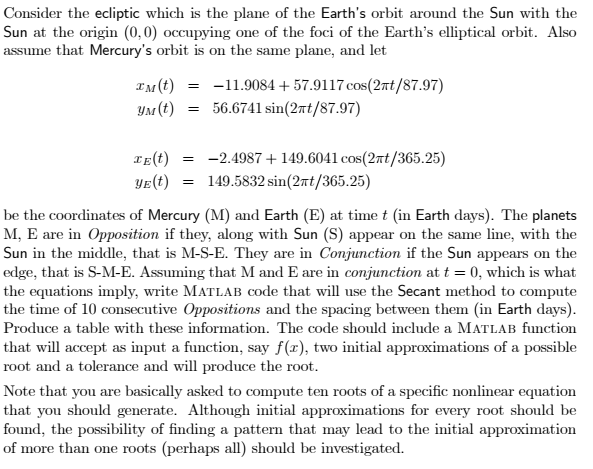
Consider the ecliptic which is the plane of the Earth's orbit around the Sun with the Sun at the origin (0,0) occupying one of the foci of the Earth's elliptical orbit. Also assume that Mercury's orbit is on the same plane, and let XM(t) Unf(t) -11.9081+57.91 17 cos(2m/87.97) 56.6741 sin(2nt/87.97) = _Te(t) ye(t) -2.4987 + 149.6041 cos(2nt/365.25) 149.5832 sin(2nt/365.25) = be the coordinates of Mercury (M) and Earth (E) at time t (in Earth days). The planets M, E are in Opposition if they, along with Sun (S) appear on the same line, with the Sun in the middle, that is M-S-E. They are in Conjunction if the Sun appears on the edge, that is S-M-E. Assuming that M and E are in conjunction at t = 0, which is what the equations imply, write MATLAB code that ill use the Secant method to compute the time of 10 consecutive Oppositions and the spacing between them (in Earth days) Produce a table with these information. The code should include a MATLAB function that will accept as input a function, say f(z), two initial approximations of a possible root and a tolerance and will produce the root Note that you are basically asked to compute ten roots of a specific nonlinear equation that you should generate. Although initial approximations for every root should be found, the possibility of finding a pattern that may lead to the initial approximation of more than one roots (perhaps all) should be investigated. Consider the ecliptic which is the plane of the Earth's orbit around the Sun with the Sun at the origin (0,0) occupying one of the foci of the Earth's elliptical orbit. Also assume that Mercury's orbit is on the same plane, and let XM(t) Unf(t) -11.9081+57.91 17 cos(2m/87.97) 56.6741 sin(2nt/87.97) = _Te(t) ye(t) -2.4987 + 149.6041 cos(2nt/365.25) 149.5832 sin(2nt/365.25) = be the coordinates of Mercury (M) and Earth (E) at time t (in Earth days). The planets M, E are in Opposition if they, along with Sun (S) appear on the same line, with the Sun in the middle, that is M-S-E. They are in Conjunction if the Sun appears on the edge, that is S-M-E. Assuming that M and E are in conjunction at t = 0, which is what the equations imply, write MATLAB code that ill use the Secant method to compute the time of 10 consecutive Oppositions and the spacing between them (in Earth days) Produce a table with these information. The code should include a MATLAB function that will accept as input a function, say f(z), two initial approximations of a possible root and a tolerance and will produce the root Note that you are basically asked to compute ten roots of a specific nonlinear equation that you should generate. Although initial approximations for every root should be found, the possibility of finding a pattern that may lead to the initial approximation of more than one roots (perhaps all) should be investigated







